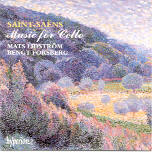The low esteem that all but a tiny minority of Saint-Saëns’ large and varied output enjoys today is incomprehensible to me. His chamber music in particular stands with the finest works of the 19th and early 20th century, and these two cello sonatas belong in very elite company. Cello sonatas are extremely difficult to write. The problems of dynamic balance between the piano and the stringed instrument, the low mean tone of the cello, and complex relationships between the principal melodic line and accompaniment all require musicianship of the highest order to resolve in terms of music that sounds natural, effortlessly integrated, and ingratiating. That Saint-Saëns does so is an understatement: these two sonatas rank with Beethoven’s and the second of them surpasses both of Brahms’ for this same combination.
The First Sonata is a passionate, three-movement work, the high point of which is a slow movement of exceptional charm and delicacy. The Second Sonata, a late piece, is astounding: huge in scope (36 minutes long), confident in expression, and executed with a true master’s skill. The four large movements include a marvelous Scherzo in the form of a theme and variations that imbues the whole work with an emotional depth and intellectual consistency that completely belies this composer’s reputation as a musical “lightweight.”
These two Swedish performers clearly believe in this music, and they play as if every moment matters. Mats Lidström deserves special credit for his strength of tone and willingness to attack the music with the passion it requires, and pianist Bengt Forsberg (already distinguished as a Lieder accompanist, principally with Anne Sophie von Otter) manages to play at full power without ever covering his partner. The two transcribed versions of “The Swan”, from The Carnival of the Animals, make charming fillers. An exceptional, important release, very well recorded and intelligently annotated. Buy it. [1/7/2000]
































